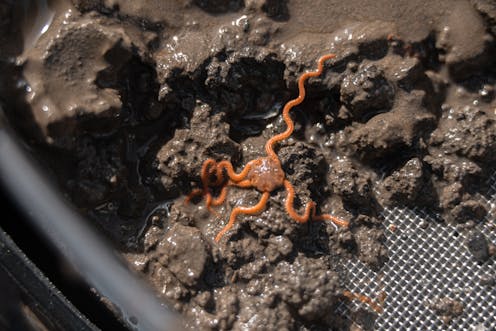
Sitting in darkness, deep below the sunlit surface, an iridescent nightmare awaits its prey. With precision and speed, it strikes and slices a passing fish clean in half with a set of jaws twice the width of its head. The armour-plated creature retreats into its hole, quarry in tow, to rejoin the bustling metropolis of animals living in a network of burrows in the mud.
This scene of a hunting bobbit worm is not one of science fiction, set on a far-flung planet. This creature lives within the seabed of the Earth’s continental shelf. This alien world, collectively the size of the North American continent, has been largely ignored.
Our current research brings the seabed to the surface of public consciousness, shedding light on the bustling community of animals living there and their importance to planetary health, the carbon cycle, and perhaps even in providing a solution to climate change.
We work for the Convex Seascape Survey, a multidisciplinary project led by Callum Roberts, Professor of Marine Conservation, seeking to understand the carbon stored in the world’s seabed. We are researching the role life and biodiversity plays in regulating seabed carbon stores through their direct link with carbon-rich sediment, and the benefits that protection from destructive fishing practices (for example, bottom trawling) may have on this.
These animal-driven processes are reflected on land. Like earthworms, which keep soils healthy via mixing and aeration, the bobbit worm and other marine worms mix seabed “soils”, along with crustaceans, molluscs and starfish. There can be hundreds or thousands of these creatures within just a square metre of sediment - depending on environmental conditions and human disturbance.
Many of these animals build extensive burrow systems. Some estimates suggest up to 32,500km³ of sediment is being constantly turned over on the seafloor by this activity. This is equivalent to approximately 13 times the volume of Mount Everest in sediment.
A ‘mudtropolis’ of life
You may have come across worm-like piles of sand on the beach at low tide. These are worm poo or casts of sediment that have passed through the worm’s body as it constructs its burrow. One of the most common marine worms around Britain’s coasts is the lugworm, which can dig burrows down to almost half a metre.
Other major sediment mixers include the sea potato, a small heart-shaped sea urchin common on continental shelves across the world. Populations of about 40 individuals per square metre can displace 150 times more sediment than the volume they ingest – even small creatures can have enormous ecosystem implications.
Convex Seascape Survey scientist Adam Porter is developing pioneering techniques for photographing and measuring the sediment moved by urchins and other species in the lab. Results from these experiments allow us to estimate the amount of carbon being moved downward into the seabed and stored by these animals on a seascape scale, which could be colossal.
We tend to protect places for their natural beauty (think coral reefs). Muddy bottoms don’t usually make the cut. Consequently, many of these seabed communities have been neglected from protected area networks and are vulnerable to activities such as bottom trawling and dredging.
These fishing activities disturb and kill many of the animals important to a healthy and functioning ecosystem and disrupt their role in the ocean carbon cycle.
Our aim as marine ecologists is to understand the connection between carbon and life in the muddy seabed. This has been overlooked in the pursuit of developing carbon stores as climate change solutions.
By highlighting the interlinked ecological and climate significance of these creatures, we hope to advocate for a more holistic approach to managing and protecting the seabed – one that recognises the seabed as the bustling mudtropolis that it is.
Dr Benjamin Harris receives funding from the Convex Seascape Survey. He works for the University of Exeter.
Mara Fischer receives funding for her PhD research from the Convex Seascape Survey.
Tara Williams receives funding for her PhD research from the Convex Seascape Survey.
This article was originally published on The Conversation. Read the original article.







